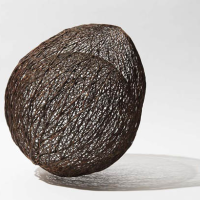31. BRONWYN OLIVER

Acorn was created in 2006, the final year of Bronwyn Olivers tragically short life. During this year, Oliver spent much of her day working exhaustively on the group of works that would be included in the exhibition at Roslyn Oxley9 planned for August that year. After months of painstaking work, Olivers meticulous sculptures were completed and ready to exhibit. The following month, she took her own life ending a chapter of Australian sculpture which had not yet finished being written.
The current work, Acorn, is just one of 305 works created by Oliver. Her unique forms rarely surface on the secondary market, most being tightly held by collectors who saw the beauty and collectability in her works during her lifetime. The demand for Olivers work has been such that over the past 10 years, prices have steadily been on an upward trajectory the average price for one of Olivers sculptures is currently $100,000.
Oliver intended to be an artist from a young age and her innate creativity, coupled with her tenacity, saw success come early on in her career. In the late 1970s, Oliver studied at the Alexander Mackie College in Sydney where she was awarded the Deans Award, later going on the win numerous prizes and awards allowing her to travel and study overseas. These awards include the Art Gallery of New South Wales Travelling Art Scholarship to London, Sydney University Cit des Arts Residency and the Mot and Chandon Australian Arts Fellowship in Paris. Oliver completed a Masters of Art in Sculpture at the Chelsea College of Arts, the same institution where some of the most well renowned sculptors of the 20th century studied, including Ossip Zadkine (1890-1967) and Anish Kapoor (born 1954).
To the viewer, Olivers forms first appear to be simple shapes however, upon closer inspection, these forms become mesmerising networks of fine soldered and woven threads which metamorphose into unique visual poetry.1 Despite Oliver rejecting the notion that her work was based in nature, the underpinning omnipresent essence of the natural world in her work shells, plants, seeds cannot be ignored. As art critic John McDonald notes, for Oliver to deny nature is akin to Balthus saying there is nothing erotic about his paintings, or Rothko claiming his works arent abstract.2 Oliver was perhaps refusing to allow the stigma of nature being associated with femininity to diminish her work. The artist worked in a predominantly male field and she aspired to have her art judged on the same terms as her male peers. Her work has a characteristic hard edge to it; despite the elegance of curved lines and exquisite patterning, the nature of the materials used by the artist brings a unique sense of durability to her sculptures.
One of the most impressive aspects of the artists career was her ability to create both small, intimate objects and large-scale public commissions. Some of Olivers best-known commissions include Palm and Magnolia, both situated in Sydneys Botanic Gardens; the 16 metre high Vine in the Hilton Hotel, Sydney and Big Feathers, in Brisbanes Queen Street Mall. The artists legacy is an enduringly beautiful body of public and private sculptures that invite our quiet engagement and contemplation. As described by Edmund Capon, former Director of the Art Gallery of New South Wales, there is beauty and certainty in her work but above all there is a poignant reaffirmation
of humanity.3
Footnotes
1. Julie Ewington, quoted in Hawley, J., TarraWarra honours Bronwyn Oliver, brilliant sculptor who died before her time, Australian Financial Review, 4 November 2016, p.14
2. McDonald, J., Bronwyn Oliver, the Sydney Morning Herald, 7 January 2017
3. Edmund Capon, quoted in Hawley, J., TarraWarra honours Bronwyn Oliver, brilliant sculptor who died before her time, Australian Financial Review, 4 November 2016, p.14
Caroline Jones BA, MArtAdmin.